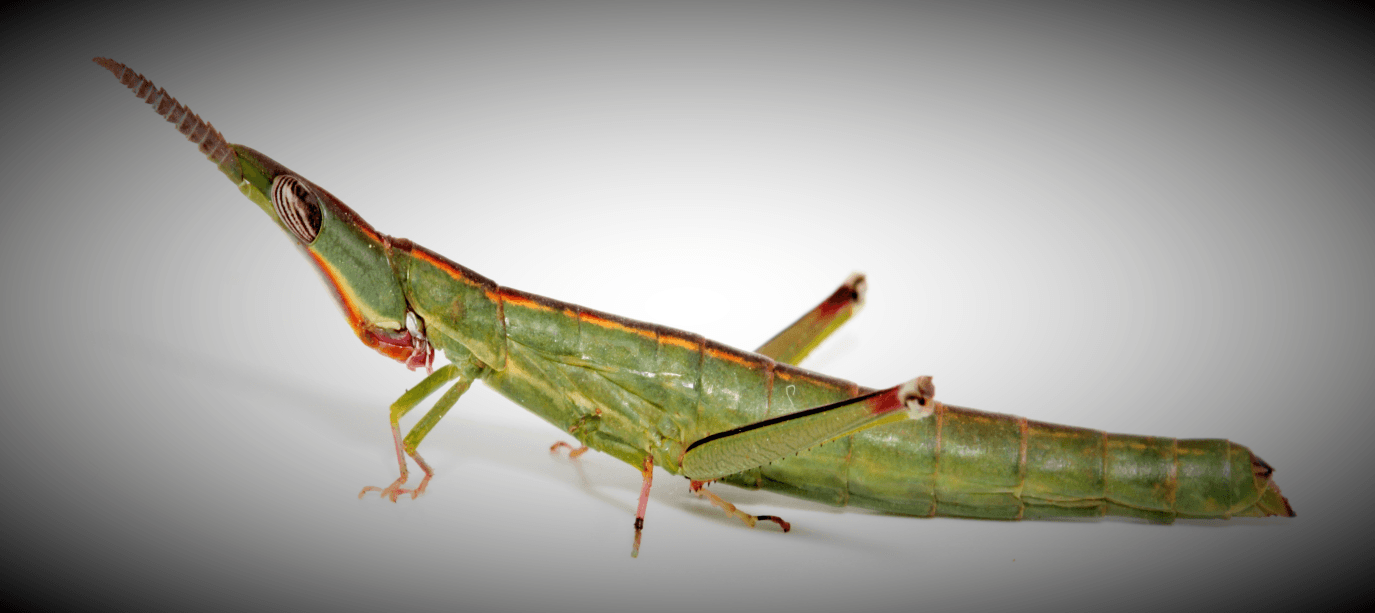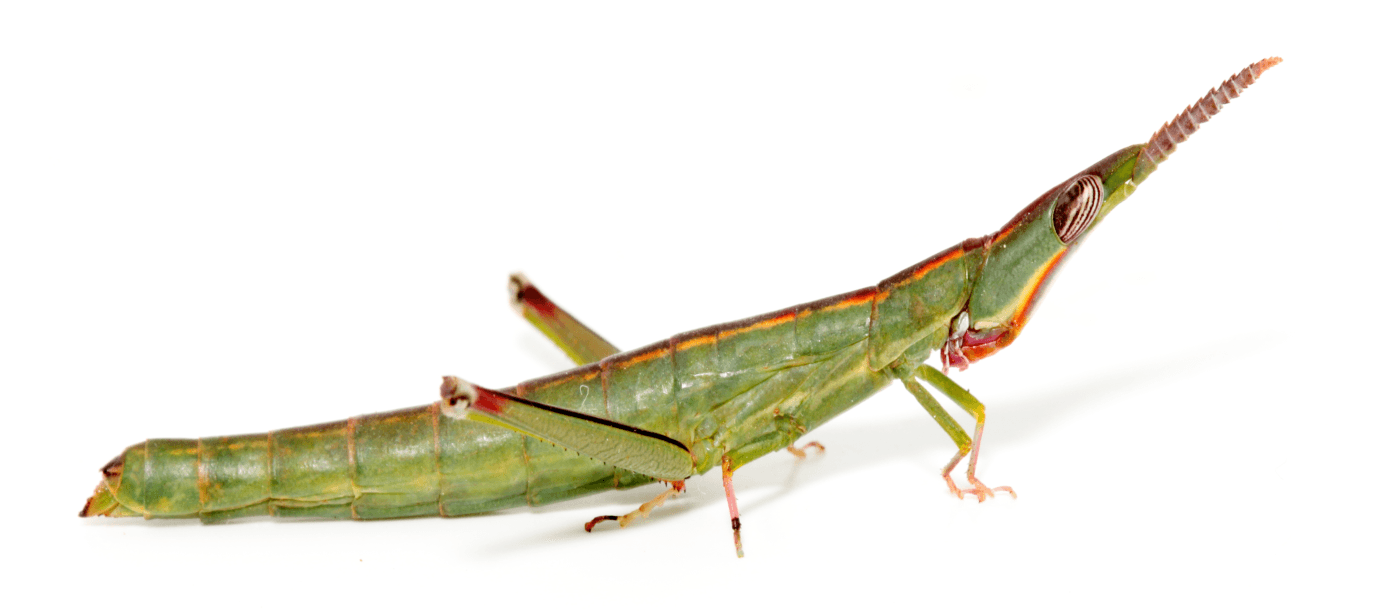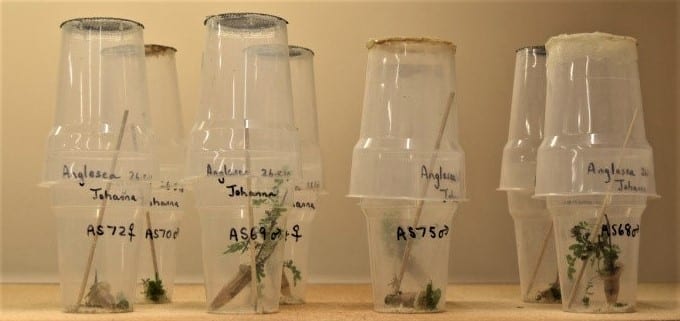
The diversity of Aussie grasshoppers | Part one
Words: Vanessa White
Images: Mike Kearney and Vanessa White
Why Australian grasshoppers are fantastic research subjects: The Morabine grasshoppers (subfamily Morabinae) commonly known as “matchstick grasshoppers” are endemic to Australia and comprise 40 genera and around 250 species (Rentz 1996). Both sexes are wingless with a characteristic matchstick-like appearance. Some Morabine species have been studied in detail due to their interesting life history traits and this includes my work with Associate Prof. Michael Kearney (“Mike” from here on) and Prof. Ary Hoffmann on the following groups:
Warramaba virgo is the only known example of an all-female grasshopper species. They reproduce by a form of parthenogenesis known as thelytoky (White et al. 1963) and their study has been a focus of many prominent scientific minds including Michael White, Graham Webb, Ken Key and Godfrey Hewitt. Mike and Ary have studied Warramaba virgo and its sexually reproducing relatives for over a decade in order to understand the evolutionary history of arid zone species. This is important for understanding how species may adapt to climate change. Mike was recently successful in elevating the status of the two W. virgo phylads [“Standard (STD)” found in eastern and western Australia, and “Boulder-Zanthus (BZ)” found in western Australia] to “species” and renamed these W. virgo and W. ngadju respectively. The inspiration for the latter coming from the Ngadju people, traditional owners of the region who have lived there for a similar amount of time as these grasshoppers (M. Kearney, pers. comm.) The Warramaba sexual species, “P196”, “P169” and “P125”, also received formal species status and are now known as W. whitei, W. flavolineata and W. grandis respectively. These species names were chosen by Mike in tribute to the trail-blazing grasshopper scientists Michael White (hence whitei), and Ken Key. Ken intended to use the names flavolineata and grandis however species recognition did not occur in his life time (M. Kearney, pers. comm.).
The Vandiemenella viatica species group is found on mainland Australia and in Tasmania in a range of climatic zones (Ary Hoffmann, pers. comm.) and is made up of 12 distinct chromosome races of which only two (viatica and pichirichi) are formally described as species at present. This group has significantly contributed to our knowledge of and debate around key concepts of speciation and hybridisation. The group was keenly studied by geneticist and evolutionary biologist Michael White whose distinguished career included a stint at Melbourne University as Professor of Zoology and Foundation Professor of Genetics (from 1958 – 1975), and expert entomologist Ken Key, as well many others (Kawakami et al. 2007, 2009 and 2011; Kearney and Hewitt 2009). Mike and Ary are interested in Vandiemenella as a model system to study local adaptation. For example, to determine if different diapause strategies result in the emergence of young in favourable conditions are location dependent. As with the Warramaba, studying this group is relevant to our understanding of climate change and affords an opportunity to extend past research, providing a good comparison with findings for Warramaba grasshoppers.
Keyacris scurra is now restricted to a handful of urban cemeteries. These isolated populations are under threat from management practises such as grass mowing. Recently Ary and Michael successfully nominated K. scurra for “recommendation for listing” as a threatened species under the Flora and Fauna Guarantee Act. Ary and Mike’s dedication to the recognition and preservation of our unique natural history, and particularly the conservation of often neglected insects is particularly inspiring to me.
Meet a magnificent female adult specimen of Warramaba whitei (formerly “P196”) collected from Diorite King Mine in Western Australia
Rearing Vandiemenella in the laboratory—Studying these grasshoppers relies on both detailed field observations and establishing colonies in the laboratory . Particularly in developing an understanding of captive rearing, diet, breeding, egg and nymph development, longevity and physiology (such as dietary requirements and thermal tolerance traits) we need to be able to closely observe them under controlled conditions. I have been looking after multiple wild-caught Vandiemenella chromosome races including pichirichi, viatica 17, viatica 19, P24, P45b and P50 for about a year in Mike’s lab. These populations were collected from South Australia, Victoria and New South Wales. Laboratory rearing of Vandiemenella adults has been relatively simple so far with individuals and breeding pairs housed in a cup complex system. Each cup is labelled with a unique identifier which is maintained throughout egg production. A stick is placed inside the cup for climbing and to assist the moulting process. Typically there are 5-6 iterations of moulting, with one extra iteration typically observed in females compared to males (M. Kearney, pers. comm.) The presence of a stick may help with the moult process may be due to less restricted movement.
Adults are fed every 2 -3 days with a small sprig of “bidgee widgee” (Acaena novaezelandiae) placed in a modified Eppendorf tube to keep the leaves fresh. Vandiemenella chromosome races are found in a range of Australian habitats including coastal heath, mallee and salt bush (White et al. 1967, Kawakami 2008) and some races are known to have specific food preferences (Blackith and Blackith 1966). It is therefore remarkable that we have successfully reared six different chromosome races on the one food source to date. Their diet is supplemented twice weekly with commercial orthopteran mix comprised of muesli, fish flakes, bird seed mix, bee pollen, guinea pig pellets and calcium carbonate. It appears this has significantly boosted adult survival rate (M. Kearney, pers. comm.). To keep them hydrated the tops of the cups are misted with water after feeding, simulating dew. The colonies are maintained in a controlled room on a 12-hour day/night cycle at 25°C during the day and 15°C overnight to simulate field conditions.
The “cup complex” system used to house breeding pairs and individuals of the various Vandiemenella chromosome races (note the important stick inside each one)
A Vandiemenella viatica 19 adult female originally collected from Anglesea eating bidgee widgee
When mature females lay eggs they are collected with a fine paint brush to avoid damage to the fragile eggs. Eggs are then transferred to filter paper on top of ~1.5cm of sand in a covered petri dish. Each peri dish is labelled with the parent’s unique identifier and a unique clutch identifier, as females may lay multiple clutches of 2-7 eggs each.
The dishes are incubated between 15-40°C to determine the range of optimal conditions. Eggs are checked regularly to monitor their development. The sand in the petri dish is sprayed every second day to prevent desiccation. Those eggs that appear swollen (due to water uptake and development) and suddenly darken are then inspected under a microscope. Eggs that show movement and a well-developed nymph occupying most of the egg space are close to hatching. These are then individually buried nymph head facing upwards 2 cm deep in sand in a glass vial with a foam lid. These vials are incubated at the same temperature they were previously held at, and inspected daily for hatchlings. Hatchlings are weighed, sexed and transferred to a vial and kept at the same condition as their parents were.
The inspiration behind the petri dish based egg-rearing system came from a previous study by Ann Wilks (1973). Initially Ann placed egg clutches in individual pots with sand and watered these daily, keeping them at 32°C. However, she found that 30 egg batches (each with 8 – 10 eggs) produced only 13 nymphs and only one of these nymphs lived beyond 10 days. Ann sifted the sand to collect all the remaining healthy eggs and placed these on filter paper and again kept them at 32°C with daily watering and 70 eggs hatched but 13 of these died during hatching or the during their first moult, most of the survivors died prior to the first “above-ground” moult. Ann thus concluded the first 10 days after hatching is a critical for Vandiemenella nymph survival; those nymphs that successfully break out of the egg and complete the first post- hatching moult and then the first “above-ground” moult are much more likely to survive. Mike and his PhD student Jacinta Kong were interested in using petri dishes as it facilitates close monitoring of egg development and it was relatively successful for Ann Wilks. Jacinta and Mike decided to bury the eggs in sand at the final stage of their development because if individuals experience no contrast in light conditions during the “vermiform” (worm-shaped or pre-moult) phase when under normal circumstances they would wriggle up from under the sand into the light. Without this stimulus the nymphs don’t know they have made it above ground yet, so they keep wriggling and die from exhaustion (although significantly increasing the light intensity can prevent this issue as well) (Mike Kearney, pers. comm.)
Rearing of adults, eggs and nymphs in individual cups and petri dishes with an appropriate ID trace enables us to collect data at the level of the individual with respect to relatedness. For example, it would be much easier (and more natural) to house many adults in one cage and allow females to lay eggs in a single large pot of sand without any intervention in the egg development and nymph rearing stages. However, we would not be able to record the number of eggs laid or nymphs born to a particular female and mating pair which would substantially limit our findings.
The future of Vandiemenella laboratory rearing—Jacinta has been responsible for most of the Vandiemenella egg and nymph rearing work to date with some assistance from me. Results of our two part egg development system have been very disappointing in terms of the total proportion of eggs transferred from petri dishes to vials; approximately 80 % fail to develop at all, or show abnormal development, or, were completely engulfed by mould and fungus. Of those eggs that were successfully transferred to vials, hatching rate was reasonable at 55.5%. Of these hatchlings 66% lived for 8 or more days, which is a much better result compared to Ann Wilks’ study, but there is still much room for improvement. I think the overall poor success rate is due to the plastic petri dishes we used as these were small and did not provide adequate ventilation (as evidenced by water droplets accumulating on the inner lid) and sand was probably too damp (sand in the field is expected to go through periods of dryness and wetness due to sporadic rain). These factors suggest the humidity is too high, which promotes fungal and mould growth on and around the eggs. These conditions may have also lead to excessive water uptake by the eggs which could have disrupted their membranes and therefore made it easier for moulds and fungus to engulf the developing nymph within. I also think glass vials are a poor housing choice for hatchlings, again because of poor ventilation and high humidity inside (as evidenced by mouldy orthopteran mix) but also because they lack sufficient space for completion of the first “above-ground” moult. As well, feeding nymphs once a week only may limit nutrition.
I am particularly interested in improving nymph survival rates and this forms the basis of a new experiment (see part two next week).
References
Wilks, A. V. (1973) Studies in isozymes in virgo. Parkville: University of Melbourne.


